What're your beliefs about How to prepare your home plumbing for winter weather?

Winter can wreak havoc on your pipes, especially by freezing pipelines. Right here's how to stop it from happening and what to do if it does.
Intro
As temperature levels drop, the danger of icy pipes rises, potentially leading to costly repairs and water damage. Comprehending exactly how to avoid frozen pipes is critical for property owners in cold climates.
Avoidance Tips
Shielding vulnerable pipes
Cover pipelines in insulation sleeves or make use of heat tape to safeguard them from freezing temperatures. Concentrate on pipelines in unheated or external locations of the home.
Home heating techniques
Keep interior spaces effectively warmed, specifically locations with pipes. Open up cupboard doors to enable warm air to distribute around pipelines under sinks.
Just how to determine frozen pipes
Look for decreased water circulation from taps, unusual odors or noises from pipelines, and noticeable frost on subjected pipelines.
Long-Term Solutions
Structural adjustments
Take into consideration rerouting pipelines away from exterior walls or unheated locations. Include extra insulation to attic rooms, cellars, and crawl spaces.
Upgrading insulation
Buy top notch insulation for pipes, attic rooms, and walls. Correct insulation assists maintain constant temperatures and minimizes the risk of icy pipelines.
Securing Exterior Plumbing
Yard hoses and outside faucets
Separate and drain garden tubes before wintertime. Mount frost-proof spigots or cover outside taps with shielded caps.
Understanding Frozen Pipelines
What causes pipelines to ice up?
Pipelines ice up when exposed to temperatures below 32 ° F (0 ° C) for prolonged durations. As water inside the pipelines freezes, it increases, taxing the pipeline walls and possibly creating them to break.
Dangers and damages
Icy pipelines can result in water system disturbances, residential or commercial property damage, and expensive repair work. Burst pipelines can flooding homes and trigger comprehensive structural damage.
Indicators of Frozen Water Lines
Determining icy pipes early can prevent them from breaking.
What to Do If Your Pipelines Freeze
Immediate actions to take
If you suspect icy pipes, maintain faucets open to soothe pressure as the ice melts. Utilize a hairdryer or towels soaked in warm water to thaw pipes gradually.
Conclusion
Protecting against frozen pipelines needs aggressive steps and fast reactions. By recognizing the reasons, signs, and preventive measures, homeowners can safeguard their pipes during cold weather.
5 Ways to Prevent Frozen Pipes
Drain Outdoor Faucets and Disconnect Hoses
First, close the shut-off valve that controls the flow of water in the pipe to your outdoor faucet. Then, head outside to disconnect and drain your hose and open the outdoor faucet to allow the water to completely drain out of the line. Turn off the faucet when done. Finally, head back to the shut-off valve and drain the remaining water inside the pipe into a bucket or container. Additionally, if you have a home irrigation system, you should consider hiring an expert to clear the system of water each year.
Insulate Pipes
One of the best and most cost-effective methods for preventing frozen water pipes is to wrap your pipes with insulation. This is especially important for areas in your home that aren’t exposed to heat, such as an attic. We suggest using foam sleeves, which can typically be found at your local hardware store.
Keep Heat Running at 65
Your pipes are located inside your walls, and the temperature there is much colder than the rest of the house. To prevent your pipes from freezing, The Insurance Information Institute suggests that you keep your home heated to at least 65 degrees, even when traveling. You may want to invest in smart devices that can keep an eye on the temperature in your home while you’re away.
Leave Water Dripping
Moving water — even a small trickle — can prevent ice from forming inside your pipes. When freezing temps are imminent, start a drip of water from all faucets that serve exposed pipes. Leaving a few faucets running will also help relieve pressure inside the pipes and help prevent a rupture if the water inside freezes.
Open Cupboard Doors
Warm your kitchen and bathroom pipes by opening cupboards and vanities. You should also leave your interior doors ajar to help warm air circulate evenly throughout your home.

I am just very interested by Winter Plumbing Precautions: Preventing Frozen Pipes and I am assuming you appreciated the entire article. Those who enjoyed reading our article plz be sure to pass it around. Thank you for your time spent reading it.
Details
Comments on “Critical Approaches for Preventing Frozen Plumbing in Winter”